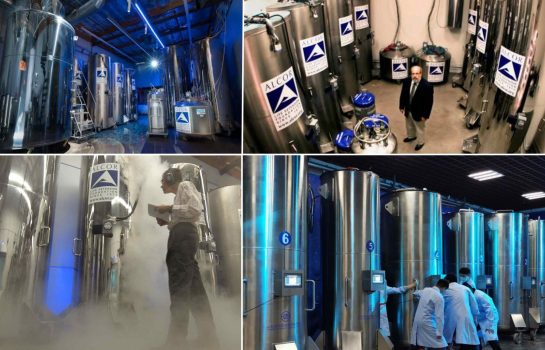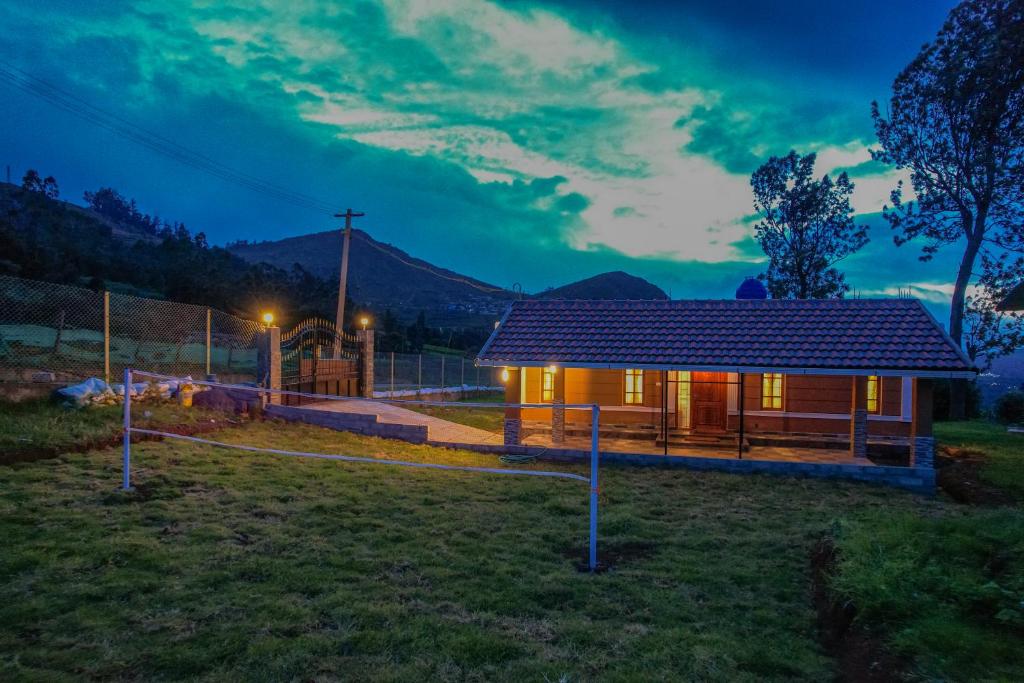 Pin
Pin Images from web
Deep in specialized facilities across the globe, hundreds of human bodies rest in stainless steel chambers cooled to -196°C. These aren’t ordinary morgues or medical research centers. They’re cryonics facilities, where people have chosen to pause their biological clocks in hopes that future science will bring them back to life.
The concept sounds like pure science fiction, yet it operates on real scientific principles. When cells are rapidly cooled to extremely low temperatures, biological processes essentially stop. No decay, no decomposition—just suspended animation in its most literal form.
Today’s cryonics industry serves those who refuse to accept death as final. Patients range from terminally ill individuals seeking a second chance to healthy people planning for an uncertain future. Each person represents a unique story of hope, desperation, or simple curiosity about what tomorrow might bring.
Table of Contents
How the Freezing Process Actually Works
The moment a cryonics patient is declared legally dead, a carefully orchestrated race against time begins. Medical teams immediately begin circulating cold preservation solutions through the body while performing chest compressions to maintain blood flow. This isn’t about bringing someone back—it’s about preventing further cellular damage.
The real magic happens during vitrification, a process that replaces blood and bodily fluids with specialized antifreeze compounds. These cryoprotectants prevent ice crystals that would normally shred cell membranes. Instead of freezing solid like an ice cube, the body transforms into a glass-like state.
Finally, patients are slowly cooled over several days until they reach the temperature of liquid nitrogen. The entire process costs between $28,000 and $200,000, depending on whether you choose just your head or your whole body. It’s expensive, but consider this: you’re essentially buying a lottery ticket for immortality.
The Science Behind the Dream
Cryonics relies on a fundamental principle: if you can stop biological decay, you might buy time for medical advances to solve whatever killed you. Scientists already successfully freeze and revive simple organisms like tardigrades and certain frogs. Human organs can be preserved for hours using similar techniques, giving hope that larger-scale revival isn’t impossible.
The challenge lies in the complexity of the human brain. Neural networks contain trillions of connections that store our memories, personalities, and consciousness. Current freezing methods cause some cellular damage, but proponents argue that future nanotechnology could repair this harm at the molecular level.
Critics point out that no mammal has ever been successfully revived after cryopreservation. Yet supporters counter that many medical procedures considered impossible decades ago—like heart transplants or gene therapy—are now routine. They’re betting that science will eventually catch up to their frozen dreams.
Who Chooses to Freeze Their Future?
The typical cryonics patient defies easy categorization. Tech entrepreneurs, scientists, and writers make up a significant portion, drawn by their familiarity with exponential technological progress. But you’ll also find teachers, retirees, and artists who simply want more time to see what humanity becomes.
Some patients are terminally ill, grasping for any chance at survival. Others are healthy individuals making advance preparations, treating cryopreservation like an unusual form of life insurance. Parents sometimes choose the procedure hoping to reunite with their children decades or centuries later.
Age ranges span the spectrum too. The youngest cryonics patient was just two years old, while the oldest was in their 90s. What unites them isn’t demographics but a shared belief that death doesn’t have to be permanent. They’re willing to gamble everything on a future they’ll never see unless the science works.
The Major Cryonics Facilities Around the World
Arizona’s Alcor Life Extension Foundation houses the largest collection of cryopreserved humans in the world. Their facility resembles a high-tech laboratory more than a morgue, with gleaming dewars (specialized storage tanks) that hold dozens of patients each. Alcor has preserved everyone’s favorite baseball player Ted Williams to anonymous individuals betting on future revival.
The Cryonics Institute in Michigan takes a more affordable approach, offering whole-body preservation for around $28,000. Their no-frills philosophy attracts middle-class families who want to stay together in the frozen future. Russia’s KrioRus serves Eastern Europe and Asia, while smaller facilities operate across several other countries.
Each facility maintains strict protocols for temperature monitoring and backup systems. Power failures or equipment malfunctions could destroy decades of preserved lives, so redundancy is everything. Some facilities have weathered natural disasters, economic downturns, and even bankruptcy while keeping their frozen charges safe at -196°C.
The Ethical Debates That Keep Scientists Awake
Medical ethicists argue fiercely about whether cryonics represents hope or harmful delusion. Critics worry that families spend life savings on unproven procedures while neglecting proven medical treatments. They question whether it’s ethical to sell services based on speculative future technology that may never materialize.
Religious leaders often oppose cryonics on theological grounds, arguing that it interferes with natural death and spiritual transition. Others counter that preserving life aligns with most faiths’ core values. The debate intensifies when parents choose cryopreservation for terminally ill children who cannot consent to the procedure.
Legal systems struggle with unique questions cryonics creates. Are preserved individuals dead or just extremely ill? Who makes medical decisions for someone frozen for decades? Courts have wrestled with inheritance disputes, custody battles, and even divorce proceedings involving cryopreserved spouses. The law hasn’t caught up to the science fiction reality.
What Revival Might Actually Look Like 🧬
Scientists theorize that successful cryonics revival would require three major breakthroughs: nanotechnology to repair cellular damage, advanced life support systems to restart biological functions, and treatments for whatever condition caused the original death. Each challenge seems monumental by today’s standards, yet researchers make steady progress in related fields.
The revival process itself would likely take weeks or months, not the dramatic awakening portrayed in movies. Patients would need extensive rehabilitation to relearn basic functions while adjusting to a completely transformed world. Mental health support would be crucial as revived individuals process decades or centuries of missed time.
Future societies might face tough decisions about reviving cryonics patients. Would they have citizenship rights? How would they integrate into advanced civilizations? Some theorists suggest virtual reality environments might ease the transition, allowing gradual exposure to new realities. The social implications could prove more complex than the technical challenges.
The Psychology of Betting on Tomorrow
The decision to undergo cryopreservation reveals fascinating insights about human psychology and our relationship with mortality. Many patients describe a profound shift in perspective once they’ve made arrangements—death anxiety decreases while future planning intensifies. They invest in learning new skills, maintaining relationships, and documenting their lives for potential revival.
Families often struggle with mixed emotions about a loved one’s cryonics choice. Some feel abandoned by partners who might return to a world without them. Others find comfort in the possibility of reunion, even if unlikely. Support groups help navigate these unique grief experiences that blend loss with lingering hope.
The cryonics community has developed its own culture and terminology. Members speak casually about “deanimation” instead of death and plan for “reanimation” rather than afterlife. This linguistic shift helps normalize what most people consider an extreme choice. Online forums buzz with discussions about revival scenarios and technological timelines.
The Economics of Immortality
Cryonics operates on a unique business model that must sustain operations indefinitely—potentially for centuries. Most facilities fund long-term storage through interest and investment returns on upfront payments. This creates an unusual situation where companies must plan for timeframes that dwarf typical business strategies.
Insurance policies often cover cryopreservation costs, making the procedures accessible to middle-class families. Some people save for years or take out loans, viewing the expense as the ultimate investment in their future. Life insurance companies have mixed responses—some embrace the niche market while others worry about fraud or disputes.
The industry faces constant financial pressures. Equipment maintenance, liquid nitrogen costs, and facility security never stop accumulating. Several cryonics organizations have failed over the decades, forcing expensive patient transfers or tragic thawing events. Survivors must trust that their chosen facility will outlast governments, economic systems, and social changes that could threaten their frozen future.
The Future of Freezing Time
Recent advances in organ preservation and suspended animation research suggest cryonics might not remain science fiction forever. Military and space agencies study similar techniques for long-duration missions, while medical researchers explore therapeutic hypothermia for trauma patients. Each breakthrough brings revival technology closer to reality.
Artificial intelligence and nanotechnology—two fields critical to successful cryonics revival—advance at unprecedented rates. Some experts predict the necessary technologies could emerge within 50-100 years, while others remain skeptical that consciousness can survive the preservation process. The timeline remains anyone’s guess, but the scientific foundation grows stronger annually.
The cryonics industry continues evolving too. New preservation techniques reduce cellular damage, while improved facilities offer better long-term security. Whether these frozen pioneers will ever wake up remains the ultimate question. But for now, they rest in their steel chambers, betting that human ingenuity will eventually conquer humanity’s oldest enemy: death itself. Only time—lots of it—will tell if their gamble pays off. ⏰
FAQs
No human has been successfully revived yet, but scientists have brought back simple organisms. The technology needed for human revival doesn’t exist today, but cryonics patients are betting it will be developed in the future.
Whole-body preservation ranges from $28,000 to $200,000 depending on the facility. Many people use life insurance to cover costs. It’s expensive, but consider you’re buying a chance at immortality!
This has happened before! Patients typically get transferred to other facilities, though it’s costly and risky. Some facilities have backup agreements, but there’s always financial risk when betting on centuries-long storage.
Nope! Biological processes completely stop at -196°C. You’d wake up exactly the same age you were when preserved. However, the world around you would have aged decades or centuries—talk about culture shock!
Yes, in most countries cryonics is legal once someone is declared clinically dead. However, laws vary globally, and some places restrict the practice. Legal status could change over time, adding another layer of uncertainty.
































